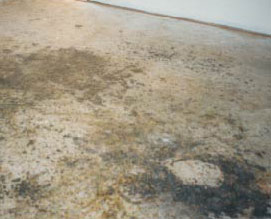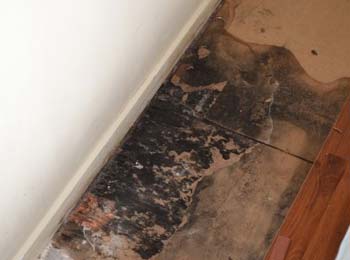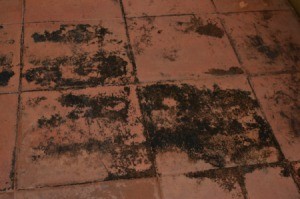The Dangers of Black Mold on Concrete Basement Floors
Black mold, scientifically known as Stachybotrys chartarum, is a toxic type of mold commonly found in damp environments, including basements. When present on concrete basement floors, black mold poses significant health risks and can compromise the structural integrity of the building. Understanding the dangers associated with black mold is essential for homeowners to take appropriate action and protect their health and property.
- Respiratory Issues: Exposure to black mold spores can trigger respiratory problems such as coughing, wheezing, and throat irritation. Individuals with asthma or allergies may experience exacerbated symptoms when exposed to mold, leading to breathing difficulties and discomfort.
- Allergic Reactions: Some people are allergic to mold spores, and exposure can result in allergic reactions such as skin rashes, itching, and nasal congestion. Prolonged exposure to black mold can worsen allergic symptoms and impact overall quality of life.
- Toxicity and Mycotoxins: Black mold produces mycotoxins, toxic compounds that can have harmful effects on human health. Inhalation or ingestion of mycotoxins can lead to more severe symptoms, including headaches, fatigue, nausea, and neurological problems.
- Property Damage: In addition to health risks, black mold can cause significant property damage, especially concrete basement floors. Mold growth weakens the structural integrity of concrete surfaces, leading to cracking, discoloration, and deterioration over time.
- Foul Odors: Black mold emits a musty odor that can permeate the entire basement and adjacent living spaces. This unpleasant smell is not only bothersome but also indicative of an underlying mold problem that requires immediate attention.
- Legal and Financial Consequences: Failure to address black mold infestations promptly can result in legal and financial repercussions for homeowners. Mold-related issues may lead to disputes with insurance companies, decreased property value, and potential lawsuits from affected individuals.

Factors Contributing to the Growth of Black Mold in Basement Environments
Several factors contribute to the growth of black mold in basement environments, making them susceptible to mold infestations. Understanding these underlying causes is crucial for homeowners to address the root issues and prevent mold from proliferating on concrete basement floors.
Moisture Accumulation: Basements are prone to moisture accumulation due to factors such as poor ventilation, water leaks, high humidity levels, and inadequate waterproofing. Excess moisture provides the ideal breeding ground for mold spores to thrive and colonize concrete surfaces.
Poor Drainage and Waterproofing: Inadequate drainage systems and waterproofing measures can result in water seepage and flooding in basements, exacerbating moisture problems and promoting mold growth. Cracks in the foundation or walls allow water to infiltrate, creating conducive conditions for mold infestations.
Lack of Ventilation: Basements with insufficient ventilation trap humid air indoors, creating a damp environment conducive to mold growth. Proper ventilation, including the installation of exhaust fans or dehumidifiers, is essential for reducing moisture levels and preventing mold proliferation.
Organic Materials: Organic materials such as wood, cardboard, and paper stored in basements provide nutrients for mold growth when exposed to moisture. Wet carpeting, upholstered furniture, and cardboard boxes are particularly susceptible to mold infestations and should be kept dry or removed from the basement.
Condensation: Condensation can form on concrete basement floors and walls when warm, humid air comes into contact with cooler surfaces. This moisture accumulation creates prime conditions for mold growth, especially in poorly insulated basements or during temperature fluctuations.
Lack of Maintenance: Neglecting regular maintenance and inspection of basements allows mold problems to go unnoticed and untreated. Failure to address underlying issues such as leaks, cracks, and inadequate ventilation can lead to persistent mold infestations and costly remediation efforts.
Effective Methods for Removing Black Mold from Concrete Surfaces
Removing black mold from concrete surfaces requires careful planning and proper techniques to ensure thorough eradication and prevent regrowth. By employing effective methods and using appropriate tools and materials, homeowners can safely eliminate mold infestations and restore the health and integrity of their basement floors.
Protective Gear: Before tackling mold removal, don appropriate personal protective equipment, including gloves, goggles, and a respirator, to minimize exposure to mold spores and mycotoxins. Ventilate the area by opening windows and using fans to prevent the spread of mold spores.
Cleaning Solutions: Use commercial mold removal products or prepare a homemade cleaning solution using a mixture of water and detergent or vinegar. Apply the solution to the affected areas and scrub vigorously with a stiff brush to loosen and remove mold growth from concrete surfaces.
Bleach Treatment: Diluted bleach can be effective in killing mold spores and preventing regrowth on concrete surfaces. Mix one part bleach with four parts water and apply the solution to the mold-infested areas. Allow the bleach to sit for 15-20 minutes before rinsing thoroughly with clean water.
Hydrogen Peroxide: Hydrogen peroxide is a less harsh alternative to bleach for removing mold from concrete surfaces. Apply undiluted hydrogen peroxide to the moldy areas and let it sit for 10-15 minutes before scrubbing with a brush and rinsing with water.
Steam Cleaning: Steam cleaning is an eco-friendly method for removing mold from concrete floors without the use of harsh chemicals. Use a steam cleaner to apply high-temperature steam to the affected areas, effectively killing mold spores and sanitizing the surface.
Professional Remediation: For severe mold infestations or large areas of mold growth, it’s best to enlist the services of professional mold remediation experts. These trained professionals have the expertise, equipment, and experience to safely and effectively remove mold from concrete surfaces and address underlying moisture issues.
Proactive Steps to Prevent the Recurrence of Black Mold in Basements
Preventing the recurrence of black mold in basements requires proactive measures to address underlying moisture issues and create an inhospitable environment for mold growth. By implementing preventive strategies and practicing regular maintenance, homeowners can safeguard their basements against future mold infestations.
Maintain Proper Ventilation: Ensure adequate ventilation in the basement by installing exhaust fans, air vents, or dehumidifiers to remove excess moisture from the air. Proper airflow helps prevent condensation and reduces humidity levels, making the environment less favorable for mold growth.
Address Water Leaks Promptly: Repair any leaks or water seepage in the basement immediately to prevent moisture from accumulating on concrete surfaces. Check for signs of water damage in pipes, walls, and foundations and address the underlying issues to prevent mold growth.
Improve Drainage Systems: Enhance the drainage around the foundation of the home by installing gutters, downspouts, and French drains to redirect rainwater away from the basement. Proper drainage helps prevent water from pooling around the foundation and seeping into the basement, reducing the risk of mold growth.
Seal and Waterproof Surfaces: Seal cracks and gaps in the foundation, walls, and floors to prevent water infiltration and moisture penetration. Apply waterproofing coatings or sealants to concrete surfaces to create a barrier against water and moisture, reducing the likelihood of mold growth.
Monitor Humidity Levels: Use a hygrometer to monitor humidity levels in the basement and keep them between 30-50% to discourage mold growth. Consider installing a humidity control system or using moisture-absorbing products such as silica gel or desiccants to maintain optimal humidity levels.
Remove Organic Materials: Minimize the presence of organic materials such as cardboard, paper, and fabric in the basement, as they provide nutrients for mold growth. Store belongings in plastic bins or containers off the floor to prevent moisture absorption and mold contamination.
When and How to Engage Mold Remediation Experts for Severe Infestations
For severe black mold infestations in basements, seeking professional mold remediation services is essential to ensure thorough eradication and prevent health risks. Mold remediation experts have the training, equipment, and experience to safely remove mold from concrete surfaces and address underlying moisture issues effectively.
Assessment and Inspection: Schedule a professional assessment and inspection of your basement to evaluate the extent of the mold infestation and identify underlying moisture problems. Mold remediation experts use specialized equipment such as moisture meters and thermal imaging cameras to detect hidden mold and moisture sources.
Customized Remediation Plan: Based on the assessment findings, mold remediation experts develop a customized remediation plan tailored to the specific needs of your basement. The plan outlines the steps and strategies for safely removing mold, addressing moisture issues, and restoring the affected areas to a healthy condition.
Containment and Protection: Before initiating mold removal, professionals implement containment measures to prevent the spread of mold spores to other areas of the home. They seal off the affected area with plastic sheeting and use negative air pressure machines to contain airborne spores and protect occupants and workers.
Safe Mold Removal Techniques: Mold remediation experts employ safe and effective techniques for removing mold from concrete surfaces, such as HEPA vacuuming, wet wiping, and abrasive cleaning. They use specialized equipment and cleaning agents designed to kill mold spores and prevent regrowth.
Moisture Mitigation: In addition to mold removal, professionals address underlying moisture issues to prevent future mold growth. They identify and repair water leaks, improve ventilation, and implement waterproofing measures to create a dry and inhospitable environment for mold.
Post-Remediation Verification: After completing the remediation process, professionals conduct post-remediation verification to ensure the successful removal of mold and restoration of indoor air quality. They perform final inspections and air quality testing to confirm that the basement is safe for occupancy.
Tips for Keeping Your Basement Floor Mold-free and Healthy
Maintaining a mold-free and healthy basement floor requires ongoing attention and preventive measures to address moisture issues and create an inhospitable environment for mold growth. By following these tips and guidelines, homeowners can keep their basement floors clean, dry, and mold-free.
Regular Inspection and Maintenance: Conduct regular inspections of your basement floor to check for signs of water damage, leaks, or mold growth. Address any issues promptly and perform routine maintenance tasks such as cleaning gutters, repairing seals, and inspecting plumbing fixtures.
Keep the Basement Dry: Keep the basement dry by addressing moisture sources such as leaks, condensation, and high humidity levels. Use dehumidifiers, fans, or air vents to reduce humidity improve airflow, and repair any water leaks or seepage promptly to prevent mold growth.
Clean and Disinfect Regularly: Clean and disinfect the basement floor regularly to remove dirt, dust, and organic matter that can promote mold growth. Use a mild detergent or cleaning solution and scrub the floor thoroughly with a stiff brush to remove mold spores and prevent regrowth.
Promote Air Circulation: Improve ventilation in the basement by opening windows, using exhaust fans, or installing air vents to promote airflow and reduce humidity levels. Proper ventilation helps prevent condensation and moisture buildup, creating a less favorable environment for mold growth.
Use Waterproofing Products: Apply waterproofing coatings or sealants to concrete basement floors to create a barrier against moisture and prevent water infiltration. Consider using moisture-resistant materials such as epoxy paint or waterproofing membranes to protect the floor surface.
Monitor Humidity Levels: Monitor humidity levels in the basement using a hygrometer and keep them between 30-50% to discourage mold growth. Use dehumidifiers or moisture-absorbing products to maintain optimal humidity levels and prevent condensation on surfaces.
Store Belongings Properly: Store belongings in the basement off the floor and away from walls to prevent moisture absorption and mold contamination. Use plastic bins or containers with tight-fitting lids to protect items from water damage and mold growth.
Inspect and Maintain Exterior Drainage: Inspect and maintain exterior drainage systems such as gutters, downspouts, and French drains to ensure proper water management and prevent water from pooling around the foundation. Redirect rainwater away from the home to minimize the risk of basement flooding and mold growth.
Black Mold on Floors? 7 Best Tips to Remove and Clean Floor!
How to Get Rid of and Prevent Mold Growth on Concrete – Environix
How To Remove Mold From Basement Walls in 2022
Removing Black Mold from Concrete Patio, Basement, Floor or Wall
How to Get Rid of and Prevent Mold Growth on Concrete – Environix
Easy Steps to Discard Black Mold on Concrete – Clean Water Partners
Tips To Get Rid Of Basement Mold
Can Mold Grow Under Laminate Flooring on a Concrete Foundation
Related Posts:
- Applying Concrete Floor Paint
- Non Slip Concrete Floor Sealer
- How To Paint Concrete Garage Floor
- Outdoor Concrete Floor Ideas
- Concrete Floor Covering Ideas
- Cracks In Polished Concrete Floors
- Drylok Concrete Floor Paint Colors
- Polished Concrete Floor Thickness
- Residential Stained Concrete Floors
- Cheap Concrete Floor Finishes












